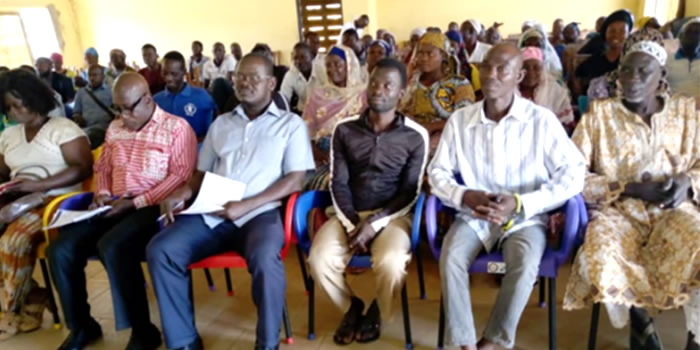

The main demographic features, which are central to the development objectives, programme and activities of Abura Asebu Kwamankese District are discussed under the following captions. The captions are so designed to create the necessary linkages establishing population as a factor, and beneficiary of development.
These are:
- Population Size and Growth Rate.
- Spatial Distribution and Household Characteristics.
- Age and Sex Composition.
- Labour and Occupational Distribution.
- Migration
The following demographic data extracted from the summary Report of Final Results, 2000 Population and Housing Census, constitutes the basis for the discussion of the subject.
Population Size
By the final summary result of the 2000 Population and Housing Census, the population size of A.AK District is 90,093 representing 5.6% share of the Regional Population and 0.47% of the National Population figure. This is also 30,523 above the 1984 District Population of 58,872 representing 51.8% increment. The population density is consequently 277.2 per sq. km. This is higher than the Regional Population density of 162.2 per sq. km yet some portions of the district is sparsely populated. The simple implication is that AAK. District remains one of the densely populated areas in the Central Region. The population size also varies according to area and community size or status.
Table (in pdf file) represents the population component, size and growth rate of 20, (Twenty selected Communities in the District).
It revealed that there is a general increase in respective community population size, however the change was relative. While the urban centres with population not less than 5000 in 1984 saw gradual increases, those in the small communities were dramatic and significant.
Spatial Distribution
The District is therefore sparsely populated with very few densely populated areas not more than 5,000 persons per community. Another feature of the District population distribution is that, the densely populated areas are lineal, lying along the main routes that pass through the District. The others, which are rural, are dispersed or dotted all over the District. This is why it is rather difficult or very expensive to locate and provide basic social amenities to benefit a large number of people.
Household Composition
Being a typical Akan speaking area and matrilineal, the household units in AAK District is still traditional. That is the extended family living in the same housing units. This has only been slightly affected by modernization, and the pursuit of different economic interests and jobs. The District Urban Population is 26,200 representing 29.1 % of the District Population while the Rural Population is 63,893 representing 78.9%. The simple implication is that the Abura Asebu Kwamankese District remains predominantly rural.
The structure of the household therefore is defined in terms of the relationship of members of the household to one person they accept and recognize as family head. Members of the household are therefore the family head and the lineage (children, sisters, grand children and great grand children). AAK District Household structure and composition are direct reflection of the social structure, economic activities, level of education, migrations and some times traditional religious beliefs.
Housing Characteristics
From the household socio-economic Survey, the following information emerged. The distribution of households by size has several implications for development in the future as it is influenced by the type of houses, for example detached or compound, and generally forms the basis for determining housing requirements.Out of total number of 360 households investigated, 35 percent comprised households of up to 3 persons and 40 percent consisted of households of four to six persons and some 9 percent between six and 9 persons although as high as 16 percent of the households consisted of 10-12 members; these households are generally found in compound houses. Households occupying less than 4 habitable rooms constituted 34 percent while those having 4 to 6 rooms comprised 30 percent and 7 to nine rooms 22 percent.
Marital Status
As a high proportion of the adult population married is regarded a potent indication towards a stable society, it is surprising that as low as 56 percent of the adult population claimed to be married while a high proportion of 34 percent were single, a foreboding situation in terms of sexual behaviour and its consequences in the form of sexually transmitted diseases.
Residential Status
The Survey revealed that about 90 percent of the population usually stayed all the year in their places of residence or in the District while some 10 percent had stayed outside the District. The residential stability augurs well for project location and promotive of high stable utilization of social facilities.
Accessibility to Health Facilities
The study showed that seventy one percent of the population did not have major difficulties in getting access to health facilities. Problems encountered were those of cost charge at the facilities including drugs. Forty one percent had such problems. Also 21 percent indicated the problem of transportation cost to and from the facility, a reflection of the poor condition of motorable roads.
Household Income and Expenditure
Generally, household incomes are low in the District. The average household earning per annum is about 0 600,000. This ranges between 01,400,000- 024,000,000 per annum. in the informal sector, the income levels of many artisans fluctuate according to seasons. For instance, tailors and dressmakers make good returns during festive occasions and vice versa on ordinary periods. Bakers on the other hand, generally have uniform income levels throughout the year, as the demand for their product is relatively consistent. In the same way, the garages, market women, petty traders and some others have fairly stable levels of income throughout the year.
Farmer’s income earnings are exceptionally as they make sales mainly when their products are harvested for the market. Furthermore, their produce has unstable prices on the market which many a time, is to their disadvantage. Worse still, many borrow cash and other items in the off-season and even for their farming activities only to defray these costs when the harvest is made. These sometimes leave farmers with barely little or no cash at the end of the harvest period. Another category of regular income earners are Public Servants. Civil Servants have rather regular income earnings. However, this is also generally low.
All these categories of workers have common expenditure patterns in terms of food, healthcare, school fees, transportation, water, electricity, and shelter.Yet, the extent of consumption of these items varies. Many persons in the lower income bracket cannot afford to enjoy many of these services even though the services are available.These sections of people could be considered poor to some extent. On the whole, very few people live affluent lives and are able to afford the luxuries of life. The large masses nonetheless, survive through the combination of two or more income generating activities, which ensures some regular flow of income throughout the year. 1.3.11 Housing Conditions
Age of Houses
The study revealed that 24 percent of the housing stock was constructed over 60 years ago. Another 21 percent of the houses are over 40 years old followed by another 23 percent constructed 30 years ago and 33 percent built during the last 18 years or so. Hence, 45 percent of the housing stock is now over 40 years old.
Type of Houses
Four types of houses were observed, namely, the compound, detached, the L-shaped and the semi-detached. By far the most prevalent were the compound and the detached as the former accounted for 52 percent of the housing units and the detached, 29 percent. Thirteen consisted of L-shaped houses and 6 percent, semi-detached.
Main Features
The compound types of houses were observed to have the following features. Nine percent were standing uncompleted, 10 percent showing cracks and another 4 percent dilapidated. Fifty two percent of them consisted of units whose wall building material was mud, 28 percent of sandcrete (blocks) and 19 percent of landcrete (bricks). The most common roofing material was galvanized iron sheets (43 percent of the houses) and aluminium (36 percent). Six percent of the detached houses were standing uncompleted, 3 percent showing cracks or dilapidated.
Twenty percent had walls constructed with mud, 36 percent with sandcrete and as high as 44 percent with landcrete. Forty two percent were roofed with galvanized iron sheets, 35 percent with asbestos and 16 percent with thatch. Eleven percent of the L-shape houses and semi-detached houses were each standing uncompleted and 6 percent each dilapidated. The Survey observed 16 of the houses leaking and 21 percent with exposed foundations. Fifty two percent of the houses suffered from erosion, 23 percent, poor drainage, 15 in unkempt surroundings and 11 percent with stagnant water.
Facilities
Toilet facilities were internally available to the extent of 11 percent of the houses, 19 percent externally and 40 percent in the form of publicly provided facilities. Twenty percent of the houses had internal bathrooms, 22 percent internal kitchen facilities and 4 percent internal water supply and 32 percent were provided with electricity. Ninety nine percent of the houses practice dumping as the method of refuse disposal. Sixty one percent of the households complained of the water problems.
As the bulk of the population live in 11 settlements consisting of more than 1,000 persons and in settlements along the Fosu-Cape Coast highway, 47 percent of the households claimed to have access to pipe-borne water, followed by borehole (30 percent) and hand-dug well (17 percent) as well as stream (5 percent), rain water remaining the most important in the rain season. Those accessible to pip-born water complained about interruptions in the flow of water.
House Occupation
Three types of occupation of houses were found in the study, namely, the landlord, tenants and free occupants, usually members of the extended family. Forty two percent of the houses were occupied by the landlord, 18 percent by tenants and 40 percent by free occupation. The type of occupation has replacement and maintenance implications. As long as the landlord remains the owner, the chances for maintenance are high as many of the poorly maintained houses are landlords through maternal inheritance. The free occupation does not seem to promote conditions for the needed sustained maintenance if such ageing buildings some occupied by the third generation or owners since construction.
Household Expenditures Pattern
Household expenditure pattern provides indication of the average marginal preferences or choices given a certain income size and are therefore used in percentage terms as ’weights" for the construction of consumer price index. The survey was, therefore, interested in finding out the proportions of expenditures by type, including such expenditure objects as funeral and savings (investment) and the following is the outcome.
By this table in pdf file, it is still clear that Agriculture and fishery is central to the occupational structure of the District. Industry follows because there are many enterprises that use raw materials from agriculture for production (backward integration). An equally large proportion buys and sells farm produce and finished products from in and out the district, hence the significant proportion of sales.
On the other hand clerical work, administrative and managerial services have low percentages because there are not many public institutions and more so private institutions with well-developed organizational structure in demand for such caliber of employees. The rate of investment is low even though there are several investment potentials to be tapped. This is an area the District will have to work on to improve upon its economic gains.
Migration
The trend of migration in the District is basically rural-urban. This is primarily due to the rural nature of the District and the fact that attractive job opportunities are located mainly in the larger communities or urban centres. There is internal migration where people move within the District basically within the rural communities and the urban ones. On the other hand, there is out migration where people from the District travel outside the District to places like Mankessim, Takoradi, Oda, Swedru, Kumasi and Accra.The migrants are mainly the dynamic labour force looking for better-paid job opportunities. Consequently, majority of the skilled and literate labour force are working outside the District.
It has been established that migration is so high that out of the District households, 47 - 50% have at least one member migrated.
The District also experiences some in-migration from the urban centres usually outside the District, to the rural areas. Specifically, the District attracts large migrant farmers particularly the Gomoas, Ewes and Akans to the cocoa industry. It is estimated that 60 - 70% of the cocoa farmers in the District are migrant cocoa farmers from these tribes. On the whole, it must be said that the out migration is far higher than the in migration. These demographic characteristics pose the following challenges;
- Reducing the high illiteracy rates.
- Reducing the large dependant population size.
- Managing the high fertility rates to reduce population growth rate and size.
- Managing and developing the high rural population Nurturing the high infant and dependant population to maturity.
Development Implications
The development implications are:
- Population control to avoid over population.
- Promotion of planned settlement.
- Housing, housing types,
- he use of appropriate technologies including building materials.
- The use of religious denomination as an agent of development.
- Involvement of the majority of people who are women in decision-making.
- Introduction of alternate employment opportunities to accelerate development and reducing over dependence on agriculture.
- Improving literacy rates as a measure of accelerated development.
- Empowering female with emphasis on rural women as a measure of accelerating development.
- Population age, sex and labour distributions are factors that should be key in determining project planning horizon, project type, project target, and project cycle. The main demographic features, which are central to the development objectives, programme and activities of Abura Asebu Kwamankese District are discussed under the following captions. The captions are so designed to create the necessary linkages establishing population as a factor, and beneficiary of development.
- Population Size and Growth Rate.
- Spatial Distribution and Household Characteristics.
- Age and Sex Composition.
- Labour and Occupational Distribution.
- Migration
Date Created : 11/10/2017 6:50:44 AM









 facebook
facebook
 twitter
twitter
 Youtube
Youtube
 +233 593 831 280
+233 593 831 280 0800 430 430
0800 430 430 GPS: GE-231-4383
GPS: GE-231-4383 info@ghanadistricts.com
info@ghanadistricts.com Box GP1044, Accra, Ghana
Box GP1044, Accra, Ghana